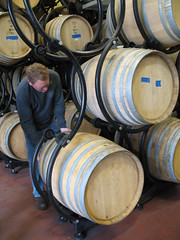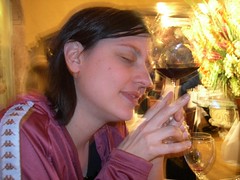Kenneth Volk on Cabernet, TCA

Ken Volk and his rolling barrels
Before I visited Kenneth Volk wineries, I knew about the trouble with TCA, or "cork taint", that nasty stuff that makes your sixty dollar Brunello taste and smell like a bleach spill in a cardboard box, but I didn't know exactly what it was. Something about mold, something about chlorine. Ken Volk explained TCA me in such a way that made it perfectly clear for the first time. TCA (trichloroanisole) is a product produced by molds that are trying to survive under extreme stress. The stress is caused by chlorine, which is used to eliminate them. What mold doesn't die pumps out TCA in an attempt to survive.
He knows a bit about TCA. When he moved into the old Byron wine facility, it, and the mold that caused it, were in the walls. He invested in massive cleanup and modifications (still going strong) and has released some of the best wines I've tasted so far.
Ken was the impetus behind Wild Horse winery, which produced 200,000 cases in its heyday before it was sold in 2003. Since then, he has put his energies into rebuilding his new winery and making wines under his pet label, Aqua Pumpkin.
Ken uses a method I've never seen before: if you look at the photo above, you'll see that each of his red wine barrels is on a rack with wheels. This allows Ken and his crew to individually turn each barrel without having to move it. The first thing I thought of was: wow, this probably cost him a pretty penny. But I think it might have been worth it. His reds are lovely.
Ken's Carmody McKnight Vineyards Cabernet Sauvignon was the best I've had so far. Not even a smidgeon of that 'bell pepper' business, and beautifully balanced through the palate. I was inspired to whip out my recorder and ask the man about this.
Ken Volk on Cabernet Sauvignon
C&D: What is it that makes the difference between Cabs with more of that vegetal, bell pepper characteristic and ones with less?
Ken: Well the pyrazines, the methyl pyrazines (aromatic organic compounds) are what you find in both Sauvignon Blanc and Cabernet Sauvignon. And those compounds, at relatively low levels, can make wines seem more leafy, more vegetal, jalapeno or bell pepper. Typically, you'll find those in cool areas where you grow the fruit, where there's not a lot of light hitting the berries...you can grow vegetal Cabernet Sauvignon in hotter climates if you're really socking the water to it and, you know, cropping too high. But basically, it's about balancing those pyrazines. You need enough to make it varietal, but too much makes it 'veggie'. It's also getting the fruit ripe enough, if you pick at higher maturity, you'll probably have less of that characteristic than at lower maturity. In general, riper picking and proper canopy management (is the way to acheive the best results).
What about the rest of the terroir equation, in relation to this?
Good draining soils...generally speaking, the heavier the soils, the more vegetal characteristics you're going to see. On really well drained soils it's easier to control vigor.
********
Will blogger ever download my photos again? Will I ever get to Paso Robles? Will my laundry ever finish? Stay tuned!
Clinkies!





1 Comments:
Very interesting post about veggies and TCA. While in SB- check out Jaffurs- if you need a hookup, let me know. They are in the city of SB, and they make the best Rhone wines in this country...
Happy Trails!
Post a Comment
<< Home